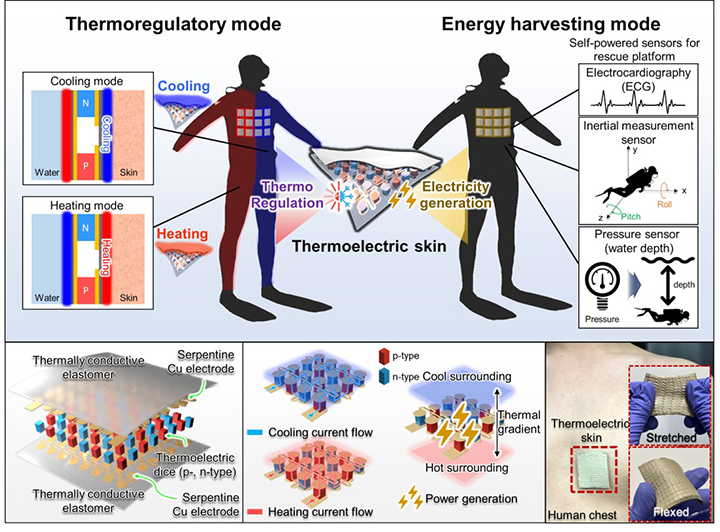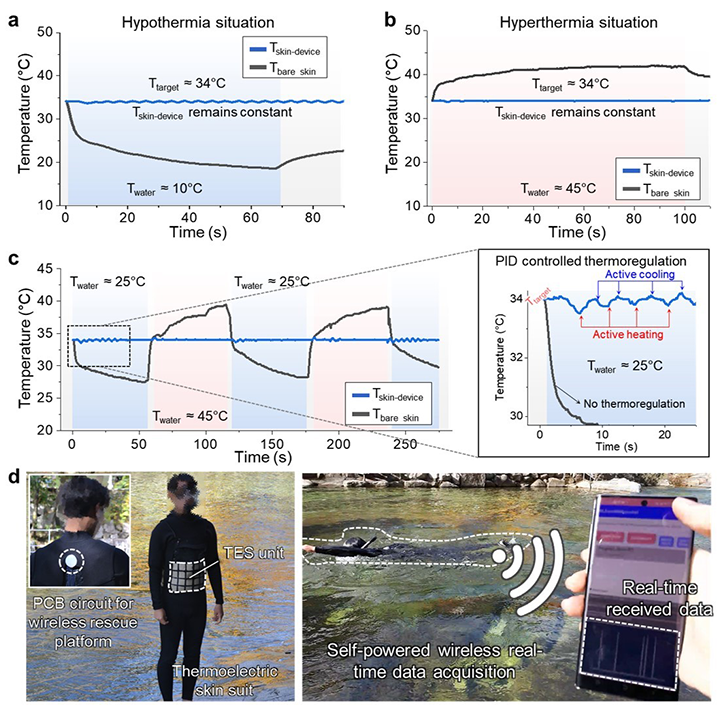Implementation of self-powering energy harvesting, which enables monitoring of the human body signal, and human thermoregulation in the underwater environment
Expected to greatly contribute to more advances underwater work and activities by increasing the safety of divers
Expected to be applicable to various extreme high and low temperature environments as well as underwater

From left, Professor Seung Hwan Ko, Ph.D. students Yeongju Jung and Joonhwa Choi of Seoul National University, and Dr. Jinwoo Lee of Georgia Institute of Technology
Professor Seung Hwan Ko of the Department of Mechanical Engineering has developed an electronic skin that can regulate the body temperature and generate the electricity by itself according to the user's needs in the underwater environment.
Recently, deep-sea rescue operations have frequently occurred due to deep-sea development, deep-sea military operations, or large-scale maritime accidents. Therefore, there are frequent situations in which long-term underwater work is required. Because the temperature in the underwater environment is lower than that in the atmosphere, a diver may experience hypothermia when working in the water for a long time. In addition, the driver often suffers from hyperthermia because of the thick layer of the neoprene dry-suit. For safe long-term underwater work, it is necessary to continuously monitor the diver’s physiological condition as well as to maintain the diver’s body temperature.
Through this research and development, the research team has developed a new thermoelectric skin that is attached to the skin while being connected to a neoprene dry-suit. This thermoelectric skin usually self-generates in order to detect the diver’s ECG, posture, and position(depth), and helps physical activity in the water by controlling body temperature when there is an abnormality in body temperature, such as hypothermia and hyperthermia.
Recent advances in soft electronics technology have enabled a wide range of applications to support a variety of underwater activities. Till now, power supply of electronic devices in the water has mainly depended on the form of a solid and bulky battery, causing inevitable technical difficulties in supporting actual underwater physical activities or underwater naval operations. Accordingly, leading domestic and foreign researchers have been concentrating on developing wearable devices that can generate power by themselves without interfering with body movement.
The research team paid attention to the difference in heat between body temperature and water temperature to generate electricity in the underwater environment. The research team developed an elastic and soft thermoelectric device-based electronic skin that could attach to the skin, allowing it to generate electrical energy from the large temperature difference between the surrounding seawater and the diver's body. In addition, the same element cooled or heated this skin to keep the body temperature of the diver constant.
The thermoelectric device mentioned here refers to a device that converts thermal energy and electrical energy. The device can be cooled or heated depending on the direction of the applied current (Peltier effect) or the current flows due to the potential difference caused by the temperature difference (Seebeck effect).
The electricity, generated through the temperature difference between water temperature and body temperature, is a continuous power supply method to detect the biosignals of divers who are active in the water for a long duration. It allows you to understand the user's current status in real time. In addition, in order to perform continuous cooling and heating (body temperature control mode), which is another function of the underwater electronic skin, a heat sink must be mounted on the thermoelectric element. The surrounding seawater acts as a natural infinite heat sink, facilitating the divers' body temperature regulation.
Officials expect that the electronic skin for such an underwater rescue platform can safely ensure long-lasting water rescue activities of divers. The research team detected biological movement-related signals through self-generation in real underwater conditions, and confirmed that body temperature could be maintained constant in various thermal conditions.
Professor Ko noted, “We expect this achievement will provide valuable assets and insights for the development of future underwater electronic and energy harvesting technologies to facilitate human underwater activities. And it is expected that it can be used to enhance the safety of workers not only in the underwater environment but also in various extreme high and low temperature environments.”
The research findings were published online on January 31, 2022, in <Nano Energy>, a renowned academic journal in the energy field.
For further information, please contact Prof. Seung Hwan Ko.





